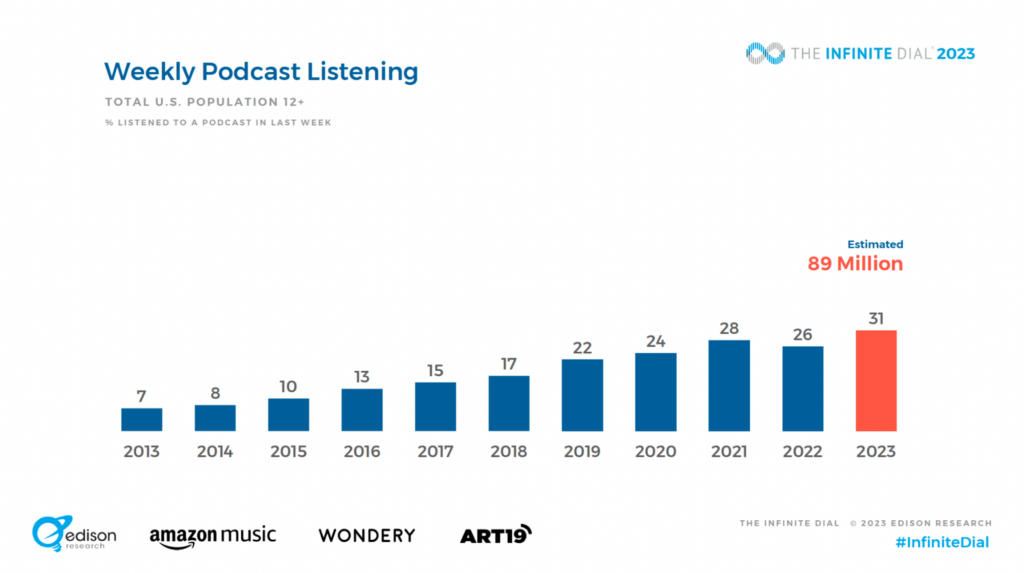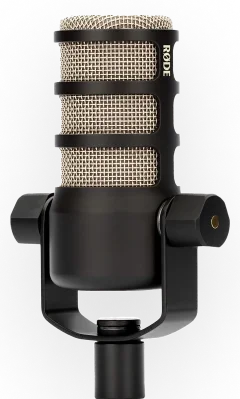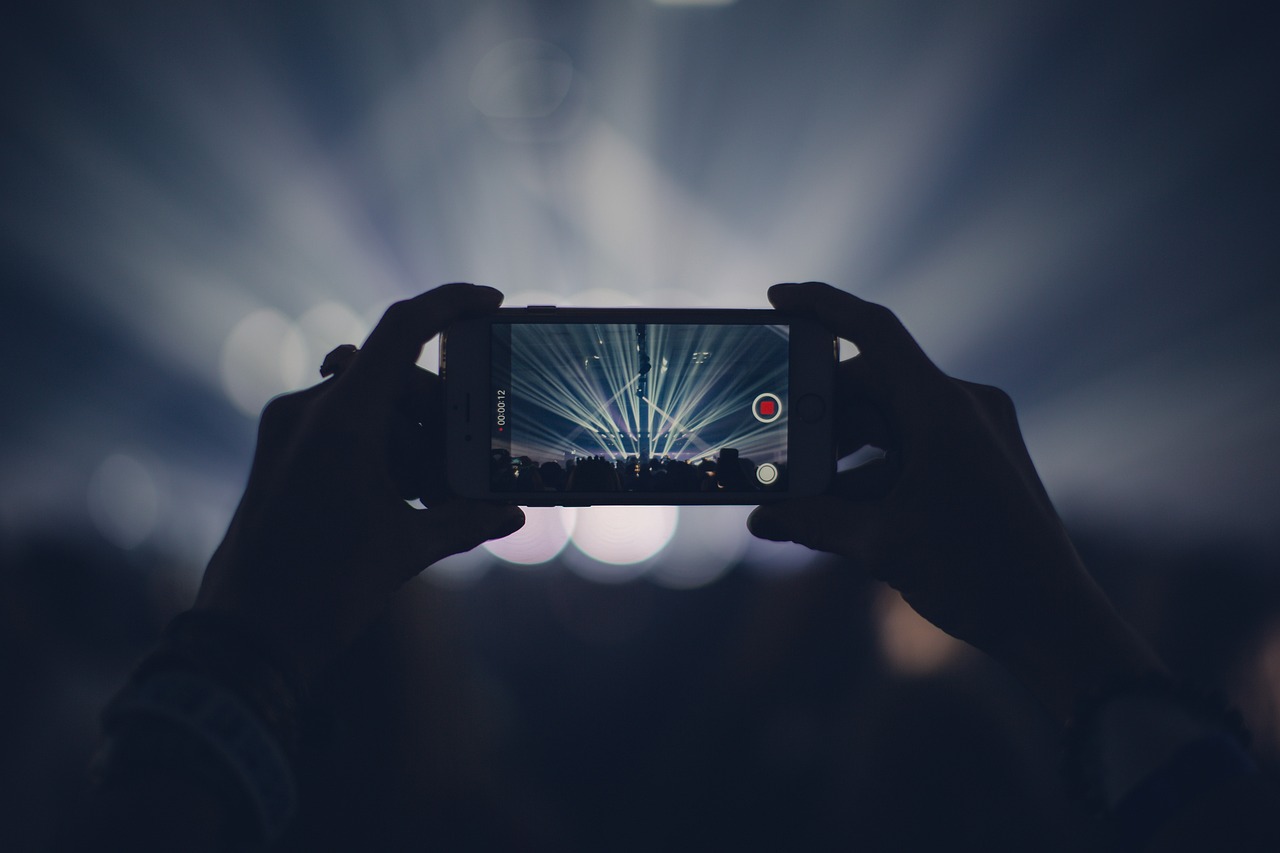This week on the product Deepdive: Angelica Potes walks Bryan through the Mediastream streaming platform. With over 15 years of experience creating streaming solutions, Mediastream enables companies manage, distribute, host, and grow their audiences from one location. Tune in now!
Hello – Captain Obvious here. I wanted to point something out regarding the latest Share of Ear data from Edison Research that, frankly, is staring us all in the face, but we need to talk about it nonetheless.
Edison’s Insights newsletter last week gave us this bit of good news about podcasting’s share of total audio time in the US:

That’s right: since 2014, when Share of Ear began tracking all forms of audio, the percentage of total audio time Americans 13+ spend with podcasting has more than quadrupled, from 2% to 9%. Over that time, the number of hours per day we spend listening to audio has remained the same, at around four hours per day, so these gains are real in what has been a zero-sum game in the battle for our earballs.
To math this up a bit, that means that the average American now spends about 22 minutes a day listening to podcasts. You might be tempted to see patterns in this number (like the well-worn trope of the 22-minute commute), but no, 22 minutes does not, as we say in stats, reflect the central tendency of this data. The Share of Ear data is an average of ALL Americans, the majority of which do not listen to podcasts every day, so that 22-minute average is the product of a lot of zeros getting averaged with some much higher numbers.
In 2014, that figure was 2%, or about 5 minutes a day spread across all Americans. So, in proportion to the share, the number of minutes per day we spend on podcast listening has also quadrupled. 4X seems like a pretty good result, but how can we equate that to the health of podcasting? Could it be higher? Should it be higher?
The answer is in a simple ratio that is right there in plain sight: the relationship between the growth in time spent listening to podcasts and the growth in listeners. For this, we turn to another Edison study, sponsored by Wondery and ART19, the Infinite Dial 2023. According to the latest podcast listening data from that report, the current percentage of Americans 12+ who listen weekly is now 31%. In 2014 (when Share of Ear started tracking cross-audio usage) that figure was 8%.

My Commodore 64 VisiCalc tells me that 31 divided by 8 is about 4, rounding up for dramatic effect. That means that weekly listeners over the same period of time tracked by Share of Ear have also quadrupled. Now, averages are never simple. The people who have recently discovered podcasts are unlikely to be spending as much time with the medium as the people who have been listening for 10 years or more. What is more likely to be the case is that new listeners come aboard with a low figure for daily listening (maybe a few minutes) while longer-tenured listeners continue to add hours to their already robust consumption. But the fact that the 4x ratio for listener growth matches the 4x growth for total share of audio is a very good thing – it means that we haven’t exhausted our “core.”
Let me unpack that a bit, as that is a bit dense. As long as the ratios between listener growth and actual time growth are similar, this means that podcasting is still on an upward trajectory: either new listeners are listening a ton, or core listeners are listening more than they used to, or both. In practice, we know that the newer you are to podcasting, the less time you spend per day listening to podcasts. So the fact that listener growth is not diluting the growth in share of time means that people who have been with the medium for a while are still adding new time every day to listen to podcasts.
Here is the alternate scenario: listener growth quadruples, but the share of time merely doubles. This could be a clue that the medium is perhaps beginning to mature – listening by “core” listeners remains unchanged, while newer, more casual listeners dilute the average time metrics. These newer listeners may, or may not, “mature” into the kind of heavy listeners the core are, but in any case, any medium has its share of core, secondary, and tertiary listeners. A change in that ratio between listeners and time could be a signal that “core” usage growth is slowing, and listener behavior is such that we are adding more light usage than heavy usage. The Edison data, however, shows that this is not yet happening.
This leads me to something we should all be thinking about cross-promotion. I think many of us are used to a world in which when one podcast ends, the default behavior is to find a new podcast to listen to. That’s core listener behavior – the people who are fans of podcasting. But as we bring more and more secondary and tertiary listeners to podcasting, we can’t assume that this is their default behavior, because they didn’t come for podcasting. They came for a show, and when the show’s over, we can’t assume they are going to look for another.
Today we see cross-promoting a related podcast as the received wisdom for best practices, and that isn’t necessarily wrong. But if that one podcast promo doesn’t grab the casual listener, they may very likely be back on TikTok, not Pocket Casts. So, for some “big tent” podcasts, we might consider promoting not a podcast, but podcasting – the wonderful universe of content that is almost entirely freely available and easy to consume with apps you already use.
Earlier this year, when I was locked in a month of jury duty for the Commonwealth of Massachusetts, I recall having conversations about podcasting with my fellow jurors. More than one said, “I don’t really listen to podcasts,” followed by a podcast they actually do listen to. This is a curious thing to say, perhaps, for those of us who listen to hours of podcasts every day.
This is the gap we need to try to close – the gap between someone who listens to “a” podcast and someone who says, when asked, that yes, they do listen to podcasts. I wrote last week about the fact that podcasting has never really promoted its more utilitarian benefits (convenience, time-shifting) at any scale to mainstream Americans, and this plays into that notion.
For now, though, adding new listeners is not diluting or reducing the growth in average time spent listening to podcasts, and that’s a ratio I will continue to watch as we wind our way into podcasting’s teenage years. One thing is for certain, however: it is easier to convince someone who listens to one podcast to listen to two than it is to convince a non-listener to try their first.
New Partners
Sounds Profitable exists thanks to the continued support of our amazing partners. Monthly consulting, free tickets to our quarterly events, partner-only webinars, and access to our 500+ person slack channel are all benefits of partnering Sounds Profitable.
- NewsGuard is the news reliability data service whose journalistically trained analysts assess the credibility of news and information publishers. Their ratings help the advertising industry support quality news and avoid misinformation sources.
- QCODE – Creating Cinematic Events In Audio. With amazing storytellers, top talent, and rich sound design and production the company was founded with a focus on scripted fiction. But they have recently expanded to launch chart topping chat shows too.
Want to learn more about partnership? Hit reply or send us an email!














































































































































































































